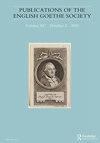《1925年曼的混乱与欢乐》和《神圣的舞蹈》(1926)
IF 0.1
3区 文学
0 LITERATURE, GERMAN, DUTCH, SCANDINAVIAN
引用次数: 0
摘要
1925年是托马斯·曼的中篇小说《无秩序的世界》出版的一年,也是他的儿子克劳斯作为小说家的处女作《从坦兹来的人》(1926年出版)的一年,这两部作品深刻地关注了规范秩序的破坏。借鉴当代魏玛关于新编舞实践和(同性恋)性行为的争论,本文对这两篇文章进行了比较阅读,探索他们如何将舞蹈作为代际场所来重新表达性代码。受尼采哲学的启发,舞蹈秩序和混乱的形象,特别是,成为了文学手段,通过父亲和儿子协商他们自己的,对比关系与同性欲望。本文章由计算机程序翻译,如有差异,请以英文原文为准。
Choreographies of (Dis)order: Dance and Same-Sex Desire in Thomas Mann’s Unordnung und frühes Leid (1925) and Klaus Mann’s Der fromme Tanz (1926)
ABSTRACT The year 1925 marks both the publication of Thomas Mann’s novella Unordnung und frühes Leid and the debut of his son Klaus as a novelist with the writing of Der fromme Tanz (published in 1926), two texts deeply concerned with the disruption of normative orders. Drawing on contemporary Weimar debates around new choreographic practices and (homo)sexuality, this article develops a comparative reading of the two texts, exploring the way in which they use dance as an intergenerational site for the re-articulation of sexual codes. Inspired by Nietzschean philosophy, images of choreographic order and disorder, in particular, become the literary means through which father and son negotiate their own, contrasting relationship with same-sex desire.
求助全文
通过发布文献求助,成功后即可免费获取论文全文。
去求助
来源期刊

Publications of the English Goethe Society
LITERATURE, GERMAN, DUTCH, SCANDINAVIAN-
CiteScore
0.10
自引率
0.00%
发文量
15
 求助内容:
求助内容: 应助结果提醒方式:
应助结果提醒方式:


